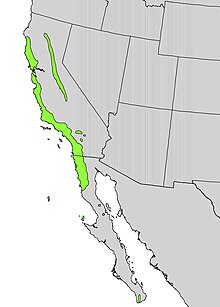| Heteromeles | |
|---|---|

| |
| Toyon bush in habitat | |
| Scientific classification | |
| Kingdom: | Plantae |
| Clade: | Tracheophytes |
| Clade: | Angiosperms |
| Clade: | Eudicots |
| Clade: | Rosids |
| Order: | Rosales |
| Family: | Rosaceae |
| Subfamily: | Amygdaloideae |
| Tribe: | Maleae |
| Subtribe: | Malinae |
| Genus: | Heteromeles M.Roem. nom. cons. 1847 |
| Species: | H. arbutifolia
|
| Binomial name | |
| Heteromeles arbutifolia | |

| |
| Natural range | |
| Synonyms[4] | |
| |
Heteromeles arbutifolia (/ˌhɛtɪroʊˈmiːliːz ɑːrˌbjuːtɪˈfoʊliə/;[5] more commonly /ˌhɛtəˈrɒməliːz/ by Californian botanists), commonly known as toyon, is a common perennial shrub native to extreme southwest Oregon,[6][7] California, and the Baja California Peninsula.[4] It is the sole species in the genus Heteromeles.
Toyon is a prominent component of the coastal sage scrub plant community, and is a part of drought-adapted chaparral and mixed oak woodland habitats.[8] It is also known by the common names Christmas berry[9] and California holly.
- ^ IUCN SSC Global Tree Specialist Group.; Botanic Gardens Conservation International (BGCI). (2020). "Heteromeles arbutifolia". IUCN Red List of Threatened Species. 2020: e.T156822115A156822117. doi:10.2305/IUCN.UK.2020-1.RLTS.T156822115A156822117.en. Retrieved 23 September 2021.
- ^ Jepson Flora Project (1993) Heteromeles arbutifolia, University of California, Berkeley
- ^ Tropicos.org, retrieved 11 November 2016
- ^ a b James B. Phipps (2015), "Heteromeles arbutifolia (Lindley) M. Roemer, Fam. Nat. Syn. Monogr. 3: 105. 1847", Flora of North America, vol. 9
- ^ Sunset Western Garden Book, 1995:606–607
- ^ "Final Environmental Impact Statement - Appendices" (PDF). Smith River National Recreation Area Restoration and Motorize Travel Management. United States Department of Agriculture: 192. December 2016.
Heteromeles arbutifolia is found in Oregon and the location southwest of Pappas Flat is not the northernmost site in the Pacific Northwest. Additionally, this site is adjacent to Highway 199 and will not be affected by the proposed actions, and is outside the geographic scope of the project.
- ^ Wood, Wendell (February 2008). "Toyon Joins the List of Oregon's Native Shrubs" (PDF). Bulletin of the Native Plant Society of Oregon. 41 (2): 11, 18.
- ^ C.M. Hogan, 2008
- ^ James B. Phipps (2015), "Heteromeles M. Roemer, Fam. Nat. Syn. Monogr. 3: 100, 105. 1847. [name conserved]", Flora of North America, vol. 9
